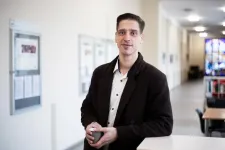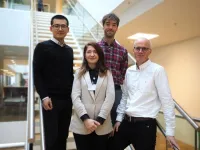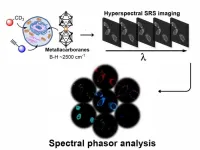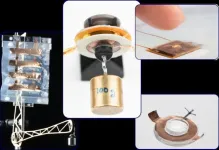Juvenile-onset systemic sclerosis (jSSc), also called scleroderma, is a disfiguring autoimmune disorder marked by hardening of the skin and internal organs, including the digestive tract, lungs, musculoskeletal system, kidneys and heart. The psychological and physical effects of the disease persist into adulthood, and many patients have a shortened lifespan. Effective therapies for severe jSSc are limited. The standard of care is the chemotherapy drug cyclophosphamide, which can cause its own significant complications. Studies in the U.S. and Europe have shown that adults who have SSc and are resistant to standard treatments can benefit from an autologous stem cell transplant (ASCT), which uses a patient’s own blood-forming stem cells to reset the immune system. Much less is known about the safety and effectiveness of the procedure in young patients.
Kathryn Torok, MD, director of the Scleroderma Clinic at the University of Pittsburgh, and colleagues felt confident in developing an autologous stem cell transplant protocol for teens and young adults because of its success in older patients and a significantly decreased risk of associated mortality. Their protocol is also less intense than some others, uses slightly less radiation and limits the amount of cyclophosphamide, replacing it with thiotepa and alemtuzumab.
The researchers’ first cohort included five patients ages 15 to 21 who were referred to the University of Pittsburgh’s pediatric scleroderma center after failing to respond to more than three immunosuppressant therapies. All met the criteria for an autologous stem cell transplant due to the severity of their symptoms.
“The only option for the first two juvenile onset patients at our center who underwent a stem cell transplant would have been a lung transplant if their interstitial lung disease (ILD) had continued to progress,” says Torok.
The researchers followed the standard protocol for stem cell transplants: medication to increase stem cells, which were collected via pheresis with CD34 selection and then frozen, followed by five days of intense chemoradiation to destroy cells in the bone marrow. The patients then received an infusion of their own stem cells, which began expanding and forming healthy new cells in the bone marrow within 10 to 20 days. The typical hospital admission time for the entire procedure was three to four weeks. Patients were then discharged to connecting Ronald McDonald House Charities apartments and continued to see bone marrow transplant and other specialists.
Clinical outcomes and patient-reported assessments were collected at baseline and up to 24 months post-transplant. The results showed an overall disease improvement of 75%, with an average 87% sustained improvement in skin thickness. Four patients had a 55% improvement in intestinal symptoms and three had a 67% reduction in heartburn, a common problem in scleroderma. There were improvements of 5% to more than 10% in lung function in a few patients. The Childhood Health Assessment Questionnaire showed a significant mean reduction among all patients at six months, while the Bone Marrow Transplant functional score increased from a mean of 68 to 86, both signifying meaningful improvement in function.
“I was pleasantly surprised [by the results],” Torok says. “The patients could physically do things they have not been able to do in years. For Example, the first patient went from being able to help his mom for about 10 minutes painting a room in the house to being able to paint the whole wall without a break or feeling exhausted or completely stiff. He became more independent, went to college, got a job, and traveled. The second patient was able to ride a bike without struggling for breath for the first time in years and was ecstatic. These are life-changing moments for these patients.”
Torok is in the process of transplanting more patients and her team is developing general guidelines for referring patients for stem cell transplants.
“The ultimate goal is that we are not waiting several years and failing several medications until we reach autologous stem cell transplant,” she says. “Our goal is to intervene earlier once safety and efficacy is proven with our current study, which so far it is. One of the practical issues we face is insurance approval. On average, it takes about 12 months from the time our center designates a patient as appropriate for a stem cell transplant to the time they are approved for it.”
Despite roadblocks, “Autologous stem cell transplant is a truly life-saving intervention for patients who have juvenile onset systemic sclerosis,” Torok says. “It is the best therapy for severe or refractory disease right now. Things may change or be modified in the future, but it is currently the best therapy.”
Current research is partly supported by the Defense Department. The original research was supported by the National Institute for Arthritis and Musculoskeletal and Skin Diseases (NIAMS) and the University of Pittsburgh Immune Transplant and Therapy Center.
###
About ACR Convergence
ACR Convergence, the annual meeting of the American College of Rheumatology, is where rheumatology meets to collaborate, celebrate, congregate, and learn. With more than 240 sessions and thousands of abstracts, it offers a superior combination of basic science, clinical science, business education and interactive discussions to improve patient care. For more information about the meeting, visit https://rheumatology.org/annual-meeting, or join the conversation on Twitter by following the official hashtag (#ACR23).
About the American College of Rheumatology
Founded in 1934, the American College of Rheumatology (ACR) is a not-for-profit, professional association committed to advancing the specialty of rheumatology that serves nearly 8,500 physicians, health professionals, and scientists worldwide. In doing so, the ACR offers education, research, advocacy and practice management support to help its members continue their innovative work and provide quality patient care. Rheumatology professionals are experts in the diagnosis, management and treatment of more than 100 different types of arthritis and rheumatic diseases. For more information, visit www.rheumatology.org.
END




